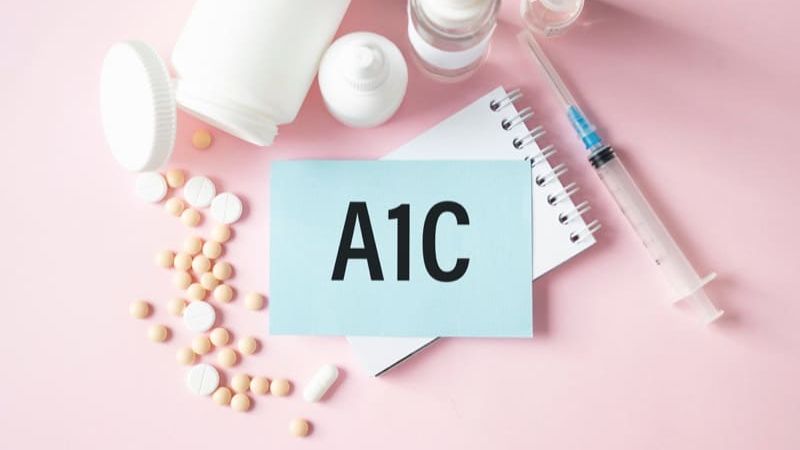

Our Review Process
Our articles undergo extensive medical review by board-certified practitioners to confirm that all factual inferences with respect to medical conditions, symptoms, treatments, and protocols are legitimate, canonical, and adhere to current guidelines and the latest discoveries. Read more.
Our Editorial Team
Shifa Fatima, MSc.
Author
Dr. Apoorva T, MHM.
MEDICAL ADVISOR
Glycated Haemoglobin test
HbA1c is one among the various tests done to measure blood glucose levels. In comparison with other tests done, HbA1c is unique and significant because it reflects the blood glucose levels averaged over the previous 2 to 3 months. The A1c test is the gold standard attestation of how well controlled your diabetes is. Let's delve deeper to figure out this enigma. Also know about yoga asanas for diabetes with pictures.
Table of Contents
What is A1C, and how is it measured?
The A1C test is also known as glycated haemoglobin, glycosylated haemoglobin, or glycohemoglobin. Our blood has red blood cells, which contain haemoglobin (Hb), a protein pigment, which binds to oxygen and carries it throughout the body. HbA1C is a component of haemoglobin that binds with oxygen. Factually, haemoglobin is what gives a red colour to the blood. As the blood sugar levels rise, haemoglobin becomes more glycated. Well-controlled glucose levels lead to less sugar-coated haemoglobin.
A Fasting Blood Glucose (FBS) test is more likely to give false positives or false negatives as your glucose levels might vary depending on what you eat. On the other hand, an A1C test has been designed based on the chemical and size of the A1C molecule. Since Blood samples can be taken anytime, and fasting is not required, HbA1c always provides a clear and reliable representation of the sugar present inside your body as an average of the glycosylation or average plasma glucose concentration in the last 2 - 3 months. Know more about sugar tablets name list.
What Can Affect Your A1C Result?
No matter how seamlessly you went through the blood sugar test HbA1c, there are always possibilities that the results may be affected by numerous factors. Some factors that may influence your HbA1c result include:
- Early or late pregnancy
- Sickle cell anemia or thalassemia (a rare haemoglobin with certain blood disorders). It is generally found in people from Southeast Asian, African, and Mediterranean continent.
- Blood loss or transfusion
- Certain medicines like opioids
- Particular HIV medications
- Lifestyle changes
Avoid taking the test when you are unwell to increase the chances of getting accurate results. Results can also be affected if you were stressed or depressed during the test. If these factors mentioned above relate to you, inform your doctor about the same before taking an HbA1c test.
How to Prepare for Your A1C Test?
A professional healthcare provider does a prediabetes HbA1c test in a well-maintained clinical setting. Since an experienced healthcare provider will do the test, you don’t have to do anything to prepare for it. However, you can ask your doctor if they will take any other test on the same day and time and whether you have to prepare for it. Know about diabetes treatment in pregnancy.

HbA1c Conversion Chart
HbA1C values have changed over time. Previously, it was expressed in percentage and was an NGSP unit, but now it has become an IFCC unit that is expressed in mmol/mol. To help you better the new HbA1c conversion Chart, we have shared a chart highlighting the old and its corresponding new HbA1c value.
| HbA1c (Old) | HbA1c (New) | HbA1c (Old) | HbA1c (New) |
|---|---|---|---|
| 4.0 | 20 | 8.1 | 65 |
| 4.1 | 21 | 8.2 | 66 |
| 4.2 | 22 | 8.3 | 67 |
| 4.3 | 23 | 8.4 | 68 |
| 4.4 | 25 | 8.5 | 69 |
| 4.5 | 26 | 8.6 | 70 |
| 4.6 | 27 | 8.7 | 72 |
| 4.7 | 28 | 8.8 | 73 |
| 4.8 | 29 | 8.9 | 74 |
| 4.9 | 30 | 9.0 | 75 |
| 5.0 | 31 | 9.1 | 76 |
| 5.1 | 32 | 9.2 | 77 |
| 5.2 | 33 | 9.3 | 78 |
| 5.3 | 34 | 9.4 | 79 |
| 5.4 | 36 | 9.5 | 80 |
| 5.5 | 37 | 9.6 | 81 |
| 5.6 | 38 | 9.7 | 83 |
| 5.7 | 39 | 9.8 | 84 |
| 5.8 | 40 | 9.9 | 85 |
| 5.9 | 41 | 10 | 86 |
| 6.0 | 42 | 10.1 | 87 |
| 6.1 | 43 | 10.2 | 88 |
| 6.2 | 44 | 10.3 | 89 |
| 6.3 | 45 | 10.4 | 90 |
| 6.4 | 46 | 10.5 | 91 |
| 6.5 | 48 | 10.6 | 92 |
| 6.6 | 49 | 10.7 | 93 |
| 6.7 | 50 | 10.8 | 95 |
| 6.8 | 51 | 10.9 | 96 |
| 6.9 | 52 | 11.0 | 97 |
| 7.0 | 53 | 11.1 | 98 |
| 7.1 | 54 | 11.2 | 99 |
| 7.2 | 55 | 11.3 | 100 |
| 7.3 | 56 | 11.4 | 101 |
| 7.4 | 57 | 11.5 | 102 |
| 7.5 | 58 | 11.6 | 103 |
| 7.6 | 60 | 11.7 | 104 |
| 7.7 | 61 | 11.8 | 105 |
| 7.8 | 62 | 11.9 | 107 |
| 7.9 | 63 | 12.0 | 108 |
| 8.0 | 64 |
Now that you know the new Hb1Ac values, you can also use an A1c test calculator to evaluate your current Hb1Ac level.
What is considered a Normal Range for A1C?
The range of the A1C determines the control you have over your blood glucose levels. According to the Center for Disease Control and Prevention (CDC) and American Diabetes Association (ADA), the Normal Ranges across categories, for HbA1c Levels are as shown in the table below.
How to Lower Your HbA1c Levels?
If the results generated after results show your HbA1c range has exceeded the target mark or range, you may become more prone to developing severe health complications. But there are effective ways around that can help you lower your HbA1c levels. Multiple factors can cause your HbA1c to rise, but you can follow the below-shared tips to lower your HbA1c levels.
- Connect with your diabetes team to review your medication plan thoroughly and change the suggested dosage per your present health conditions.
- Start getting more active. The right amount of physical activities performed regularly can help lower your HbA1c levels. Being physically active is good for everyone’s health, so you can never go wrong with this option.
- If you smoke, it’s time you stop it immediately. Smoking makes it challenging for blood to flow smoothly throughout your body.
- Try to learn more about diabetes and HbA1c by enrolling in a local diabetes education course. Ensure the course is prepared by subject matter experts and helps you learn more about diabetes and effective ways to lower your HbA1c.
- Making healthy changes in your regular diet can also bring significant results. Consult a professional dietician or nutritionist to plan a healthier and balanced diet.
You can also consider joining some online forums to get inspired by seeing others’ stories.
A1c vs Blood Glucose Values
As an indicator of diabetes control, A1C measures Glycated Haemoglobin which is expressed as a percentage. This is not always easy to understand as it does not intuitively relate to the glucose measurements you see daily through home glucose monitoring for random, fasting and post-meal or lab values, and thus difficult to translate into action.
- By measuring your blood glucose levels regularly for 90 days and then calculating the average glucose levels for the 3-month duration.
- By using the Estimated Average Glucose (eAG) : Your estimated Average Glucose number is calculated from the result of your A1c test as recommended by ADA. Like the A1c, the eAG shows what your average blood sugars have been over the previous 2 to 3 months. Instead of a percentage, the eAG is in the same units (mg/dl) as your blood glucose meter. eAG should not be the basis for treatment design but rather to get an idea of your body's sugar control.
Reference : eAG/A1C Conversion Calculator by the ADA.
Who should get the A1C Test?
The AIC testing is routinely done along with Fasting Blood Sugar tests in individuals with both Type 1 and Type 2 diabetes.
Your doctor might recommend taking an A1C test every three months to assess the changes in blood glucose levels and can also compare the values to the previous tests to see the trend of the diabetes control. If the levels are within or close to the normal range, then the frequency of the test can be reduced to once in 6 months.
Persons aged more than 45 and with a family history of diabetes or with profound risk factors such as heart disease, high blood pressure, gestational diabetes, Polycystic Ovary Syndrome (PCOS) and abnormal lipid profile, etc. are also strongly recommended to undergo an A1C test to identify undiagnosed prediabetes or diabetes.
What are Various Tips to Lower A1C Levels?
Having learned the significance of A1C, you should try to follow all or most of the below-mentioned tips to manage your diabetes effectively and have well-controlled blood glucose levels, further preventing you from associated complications.
- Doctor Consultations : You should regularly book your specialist consultations to understand the need for any modifications in medication, insulin, or other dietary changes.
- Self-awareness and Routine : You should regularly monitor your blood glucose levels, take medicine as prescribed, and follow diet and exercise plans. Having awareness and motivation are the key to a healthy lifestyle.
- Dietary Control : You should maintain control on what you eat. Always look for food labels to analyze the number of calories and processed fats before munching on them. The aim should be to reduce the consumption of complex carbohydrates and increase antioxidants, nutrients, and fibre intake. Always try to split the snack in half and consume the half.
- Relieve Stress : Stress has been considered a critical cause to increase blood glucose levels. You should reduce the level of stress and live a more relaxed life. Listening to music, spending time with family, doing yoga or meditation, and distracting from routine, are considered a few effective stress busters.
- Get Active : Leading an active life is a boon even after retiring from work. While it keeps diseases at bay, it also helps to maintain the overall mental well-being. Involve yourself in one or the other activity at home, if nothing, go for a walk.
- Exercise Routine : Studies have shown better-controlled blood glucose levels in diabetics who exercise regularly. You should make exercise a part of your routine. If you do something for 21 days regularly, it becomes a habit. Now you know the mantra to exercise regularly.
Can HbA1c results be affected by Non-Diabetes Factors?
HbA1c tests can be affected by changes in RBCs or hemoglobin. The common factors that can affect the results are -
- Blood loss
- Sickle cell disease
- Blood transfusions
- Kidney failure
- Liver disease
- Early or Late Pregnancy
- Thalassemia
- Medications
- Iron deficiency anemia - A False High HbA1c result may be seen.
When you consult your doctor, be sure to reveal all medically relevant information. Also know about random blood sugar level 180.
Bottom Line
To conclude, A1C levels give a measurement of how well managed your sugar levels are, and you should aim to keep the A1C value below 5.6%. If you are at risk, you should get tested as suggested by your doctor. Make healthy lifestyle habits a choice and not compulsion. Eating right, exercising regularly, getting active, and taking medication as prescribed can keep the A1C value in the normal range. It's the willingness to say "I will" that will help set things right. You are in charge of your body, and you understand what is best for you more than anyone else. So gear up and start adding healthy habits to your lifestyle to control your glucose levels better. Also know about glucometer.
FAQs
Is HbA1C 7.5 normal?
For those without diabetes, the normal range for HbA1C is 4 to 5.6 percent. HbA1C between 5.6 to 6.4 percent is observed in those with prediabetes. Anything higher than 6.5% is indicative of diabetes. If the HbA1C is 7.5%, then it is not normal and the person has diabetes.
What happens if HbA1c is high?
If HbA1C is high, it is an indication of diabetes. This could mean you may have other complications that come with diabetes like high blood pressure, heart disease, kidney disease, and so on. It is an indication that you need to make lifestyle changes to lead a better and healthier life and reduce your HbA1C percentage.
What is the HbA1c normal range?
An average HbA1c level is below 5.7%, which means below 39 according to the new HbA1c value. If your results are in the range of 5.7% to 6.4% or in the range of 39 to 46, it indicates prediabetes. And results exceeding 6.5% or more indicate diabetes. It is 48 and beyond according to the new HbA1c values. Also know about pre diabetes levels.
What Does A1C measure?
The A1C or HbA1c test measures the average blood sugar levels of the past three months. It is a standard test conducted by healthcare providers to diagnose prediabetes and diabetes conditions. Besides helping doctors know whether an individual has prediabetes or diabetes, this test also helps them maintain the condition.
What is the Average Blood Sugar Calculated from the HbA1c?
An average blood sugar calculated in the HbA1c test is below 5.7% (old Hb1Ac) or 39 (new Hb1Ac). If the result is in the range of 5.7 % or 39 to 6.4% or 46, it indicates a prediabetes condition. Results of 6.5% or 48 and beyond indicate diabetes condition. The higher the value, the higher is your risk of diabetes.
References
- https://www.webmd.com/diabetes/guide/glycated-hemoglobin-test-hba1c
Disclaimer
This website's content is provided only for educational reasons and is not meant to be a replacement for professional medical advice. Due to individual differences, the reader should contact their physician to decide whether the material is applicable to their case.
More by Shifa Fathima

अर्जुनरिष्ट के फायदे, खुराक और नुक्सान

मधुमेह के लिए मधुनाशिनी वटी: उपयोग, लाभ, खुराक और दुष्प्रभाव|

मधुमेह को नियंत्रित करें भारतीय आहार से





